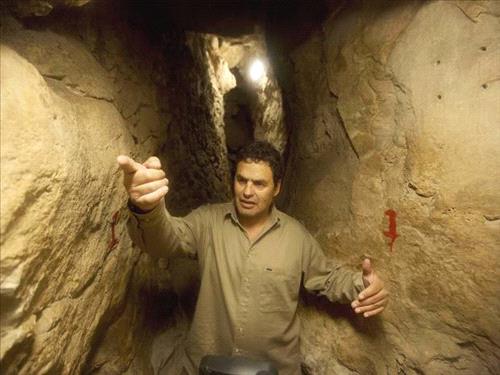Ammon News - AP - An Israeli archaeologist says he has found the citadel captured by King David in his conquest of Jerusalem in a Palestinian area of the city.
The claim by Eli Shukron, like many such claims in the field of biblical archaeology, has been criticised for the lack of evidence supporting it. His claim joins a string of announcements by Israeli archaeologists saying they have unearthed palaces of the biblical king, who is revered in Jewish religious tradition for establishing Jerusalem as its central holy city – but who has long eluded historians looking for clear evidence of his existence.
Mr Shukron places the citadel in the midst of the Palestinian neighbourhood of Silwan, south of the 16th-century walls of Jerusalem. Palestinian and international observers see Israeli exploration and colonisation of the Palestinian-dominated East Jerusalem as an attempt to legitimise the annexation of the territory taken from Jordan in 1967.
The £6m excavation, made accessible to tourists last month, is funded by Elad, an organisation which buys Palestinian property in East Jerusalem and settles Jews in fortified and guarded homes. Critics believe that Elad is more interested in extending Jewish control of East Jerusalem than historical accuracy.
Mr Shukron, who excavated at the City of David archaeological site for nearly two decades, says he believes strong evidence supports his theory.
“This is the citadel of King David, this is the Citadel of Zion, and this is what King David took from the Jebusites,” said Mr Shukron, who recently left Israel’s Antiquities Authority to work as a lecturer and tour guide.
“We can compare the whole site to the Bible perfectly.”
Most archaeologists do not dispute that King David was a historical figure, and a written reference to the “House of David” was found in an archaeological site in northern Israel. But archaeologists are divided on identifying Davidic sites in Jerusalem.
David is best known for his combat with Goliath, the giant warrior of the Philistines. David used a sling to disable Goliath and then beheaded him. He became the second king of the united kingdoms of Israel and Judea after Saul.
Mr Shukron’s dig, which began in 1995, uncovered a massive fortification of five-ton stones stacked six yards wide. Pottery shards helped date the fortification walls at 3,800 years old. They are the largest walls found in the region from before the time of King Herod, who expanded the Second Jewish Temple complex in Jerusalem almost 2,100 years ago. The fortification surrounded a water spring and is thought to have protected the city’s water source.
The fortification was built 800 years before King David would have captured it from its Jebusite rulers. Mr Shukron says the biblical story of David’s conquest of Jerusalem provides clues that point to this particular fortification as his entry point into the city.
In the second Book of Samuel, David orders the capture of the walled city by entering it through the water shaft. Mr Shukron’s excavation uncovered a narrow shaft where spring water flowed into a carved pool. Excess water would have flowed out of the walled city through another section of the shaft Mr Shukron discovered – where he believes the city was penetrated. Mr Shukron says no other structure in the area of ancient Jerusalem matches what David would have captured to take the city. The Bible names it the “Citadel of David” and the “Citadel of Zion”.
Ronny Reich, who was Mr Shukron’s collaborator at the site until 2008, disagrees with the theory. He said more broken pottery found from the 10th century BC, presumably King David’s reign, should have been found if the fortification had been in use then.
Mr Shukron said he only found two shards that date close to that time. He believes the reason he didn’t find more is because the site was in continuous use and old pottery would have been cleared out by David’s successors. Much larger quantities of shards found at the site date to about 100 years after King David’s reign.
Mr Reich said it was not possible to reach definitive conclusions about biblical connections without more direct archaeological evidence.
“The connection between archaeology and the Bible has become very, very problematic,” Mr Reich said.
Critics say that some archaeologists are too eager to hold a spade in one hand and a Bible in the other in a quest to verify the biblical narrative – either due to religious beliefs or to prove the Jewish people’s historic ties to the land.
Mr Shukron said he drew his conclusions after nearly two decades exploring the ancient city. “I know every little thing in the City of David. I didn’t see in any other place such a huge fortification as this,” said Mr Shukron.
The City of David Archaeological Park in Silwan is popular with tourists but unpopular with Palestinians who see it as part of a policy to move them out of their homes and take over the area.








 comment replay
comment replay 